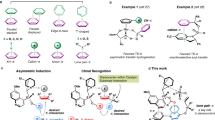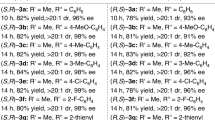Abstract
Hydrogen bonding acts as a ubiquitous glue to sustain the intricate architecture and functionality of proteins, nucleic acids and many supramolecular assemblies1,2, but this weak interaction is seldom used as a force for promoting chemical reactions3,4,5. Here we show that a simple chiral alcohol uses hydrogen bonding to catalyse an important family of cycloaddition reactions of a diene with various aldehydes — moreover, this reaction is highly enantioselective, generating only one of the mirror-image forms of each dihydropyran product. This type of catalysis mimics the action of enzymes and antibodies, and is unlike traditional, metal-based catalysts used in organic chemistry6.
Similar content being viewed by others
Main
Important biological molecules such as DNA and proteins, and therefore many pharmaceutical drugs, are chiral — that is, they are not superimposable on their mirror image (the pair of asymmetric molecules are known as enantiomers), so any chemical reaction that can selectively synthesize one enantiomeric form of a chiral compound is potentially very useful.
Candidate catalysts for such reactions are generally based on Lewis-acid metals6. On the basis of our discovery that hetero-Diels–Alder (HDA) reactions7 between unactivated ketones and 1-amino-3-siloxy diene (compound 1) are accelerated in protic solvents, we investigated the use of chiral alcohols for the asymmetric catalysis of these cycloadditions8. Of the possible alcohols that could be used for the HDA reaction between diene 1 and benzaldehyde, the TADDOL (α,α,α′,α′-tetraaryl-1,3-dioxolan-4,5-dimethanol) class of chiral alcohols, which are known to complex with carbonyl groups, was considered promising9.
Figure 1 shows the scheme of the HDA reaction in the presence of this chiral alcohol. A solution of 0.1 mmol (R,R)-1-naphthyl TADDOL (2) and benzaldehyde (1.0 mmol) in toluene at −78 °C was treated with diene 1 (0.5 mmol) and stirred, causing a smooth HDA reaction to take place. Analysis of the reaction mixture by 1H NMR indicated that the cycloadduct had been formed as a single diastereomer (3, where R is C6H5), tentatively assigned as endo. On treatment with acetyl chloride (1.0 mmol), the cycloadduct was converted to dihydropyrone (4, 70% overall yield).
The reaction is catalysed by hydrogen bonding and yields specific enantiomeric molecules (see supplementary information for eight examples of products — molecules 4a–h — bearing different R-groups). TBS, tert-butyldimethylsilyl derivative; Ar, 1-naphthyl group. The experimental procedure involved adding diene (1, 0.5 mmol) to a solution of TADDOL (2, 0.1 mmol) and the aldehyde (1.0 mmol) in toluene (0.5 ml) cooled to −40 °C (−78 °C for 4a, 4c and 4f). The mixture was stirred for 24 h at −40 °C (48 h for 4a, 4c and 4f) and then diluted with CH2Cl2 (2.0 ml). Acetyl chloride (1.0 mmol) was added dropwise at −78 °C, and the mixture was stirred for a further 15 min and then separated by chromatography on silica gel (yields 52–97%; enantiomer ratio 96:4→99:1).
Analysis of the product by high-performance liquid chromatography revealed that the S-enantiomer had been produced preferentially over the R-enantiomer (>99:1). The reaction is considerably accelerated by TADDOL (2): in its absence, there was no reaction under otherwise identical conditions. Moreover, the monomethyl and dimethylether derivatives of 2 were poor catalysts, indicating that the hydrogen-bonding capability of 2 is crucial for the catalytic function.
This metal-free asymmetric catalysis, which does not involve a covalent connection between the catalyst and the reactant10, can be used for cycloadditions between 1 and a range of aldehydes with different R-groups (Fig. 1). Aromatic aldehydes were particularly effective as dienophiles in these HDA reactions. The resultant dihydropyrone products (see 4a–f in supplementary information) were also consistently obtained with high enantiomer ratios. Aldehydes with aliphatic (4g) and α,β-unsaturated (4h) R-groups could be used successfully in these reactions.
Our results show that hydrogen bonding by a simple chiral alcohol to a carbonyl group can accomplish what has previously been considered to be in the domain of enzymes, catalytic antibodies and chiral metal-based Lewis acids. These studies indicate the broad potential for hydrogen-bond catalysis in asymmetric synthesis.
References
Prins, L. J., Reinhoudt, D. N. & Timmerman, P. Angew. Chem. Int. Edn 40, 2383–2426 (2001).
Martin, T. W. & Derewenda, Z. S. Nature Struct. Biol. 6, 403–406 (1999).
Kelly, T. R., Meghani, P. & Ekkundi, V. S. Tetrahedron Lett. 31, 3381–3384 (1990).
Vachal, P. & Jacobsen, E. N. J. Am. Chem. Soc. 124, 10012–10014 (2002).
Schuster, T., Bauch, M., Dürner, G. & Göbel, M. W. Org. Lett. 2, 179–181 (2000).
Jacobsen, E. N., Pfaltz, A. & Yamamoto, H. (eds) Comprehensive Asymmetric Catalysis Vols 1–3 (Springer, Berlin, 1999).
Jørgensen, K. A. Angew. Chem. Int. Edn 39, 3558–3588 (2000).
Huang, Y. & Rawal, V. H. J. Am. Chem. Soc. 124, 9662–9663 (2002).
Seebach, D., Beck, A. K. & Heckel, A. Angew. Chem. Int. Edn 40, 92–138 (2001).
Dalko, P. I. & Moisan, L. Angew. Chem. Int. Edn 40, 3726–3748 (2001).
Author information
Authors and Affiliations
Corresponding author
Ethics declarations
Competing interests
The authors declare no competing financial interests.
Supplementary information
41586_2003_BF424146a_MOESM1_ESM.jpg
Supplementary Figure S1: Representative dihydropyrans 4 that were synthesized in the reaction shown in Fig. 1. Reported in parentheses are the isolated yield and enantiomer ratios (er). The absolute configuration of 4b–e was assigned based on that of 4a. (JPG 97 kb)
Rights and permissions
About this article
Cite this article
Huang, Y., Unni, A., Thadani, A. et al. Single enantiomers from a chiral-alcohol catalyst. Nature 424, 146 (2003). https://doi.org/10.1038/424146a
Issue Date:
DOI: https://doi.org/10.1038/424146a
This article is cited by
-
Unusual KIE and dynamics effects in the Fe-catalyzed hetero-Diels-Alder reaction of unactivated aldehydes and dienes
Nature Communications (2020)
-
Role of intramolecular hydrogen bonds and electron withdrawing groups in the acidity of aldimines and ketimines: a density functional theory study
Theoretical Chemistry Accounts (2019)
-
Catalytic allylic oxidation of internal alkenes to a multifunctional chiral building block
Nature (2017)
-
Recent advances in terpenoid syntheses from China
Science China Chemistry (2016)
-
The copper(II) complex of an amino indanol derivative immobilized over chiral mesostructured cellular foam as a catalyst for the asymmetric hetero-Diels–Alder reaction
Reaction Kinetics, Mechanisms and Catalysis (2016)
Comments
By submitting a comment you agree to abide by our Terms and Community Guidelines. If you find something abusive or that does not comply with our terms or guidelines please flag it as inappropriate.




